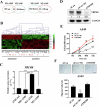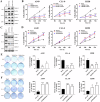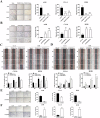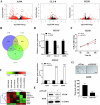E3 ligase TRIM8 suppresses lung cancer metastasis by targeting MYOF degradation through K48-linked polyubiquitination
- PMID: 39934162
- PMCID: PMC11814372
- DOI: 10.1038/s41419-025-07421-6
E3 ligase TRIM8 suppresses lung cancer metastasis by targeting MYOF degradation through K48-linked polyubiquitination
Abstract
Ubiquitination is a posttranslational modification that regulates tumour progression-associated proteins through the ubiquitin‒proteasome system, making E3 ligases potential antitumour targets. Here, we report that TRIM8, a member of the TRIM family and an E3 ligase, can act as a tumour suppressor in non-small cell lung cancer (NSCLC). Both gain- and loss-of-function experiments revealed that TRIM8 inhibits the proliferation, colony formation, migration and invasion of NSCLC cells. Experiments with a xenograft model showed that TRIM8 expression suppresses tumour metastasis in vivo. Moreover, low expression of TRIM8 was associated with poor overall survival in both the Taiwanese and GEO lung cancer cohorts. TRIM8 overexpression in lung cancer cells reduced MYOF expression, and restoring MYOF rescued cell migration in TRIM8-overexpressing cells. TRIM8 targeted MYOF for K48-linked ubiquitination, facilitating proteasome-mediated degradation and subsequently suppressing the extracellular secretion of MMPs. Our results provide new insights into the contribution of TRIM8 to lung cancer progression, suggesting that TRIM8 is a new biomarker and a novel therapeutic target for lung cancer.
© 2025. The Author(s).
Conflict of interest statement
Competing interests: The authors declare no competing interests. Ethics approval: The study on human lung adenocarcinoma specimens has been approved by the Institutional Review Board of Chung Shan Medical University Hospital (IRB CSMUH No: CS2-20206). Informed consent was obtained from all patients included in this study. The animal study was approved by the Institutional Animal Care and Utilization Committee of National Chung Hsing University, Taichung, Taiwan (Approval No: 109-111 R).
Figures








Similar articles
-
Mutual regulation between TRIM21 and TRIM8 via K48-linked ubiquitination.Oncogene. 2023 Dec;42(50):3708-3718. doi: 10.1038/s41388-023-02879-0. Epub 2023 Nov 1. Oncogene. 2023. PMID: 37914816
-
The Ubiquitin E3 Ligase FBXO33 Suppresses Stem Cell-Like Properties and Metastasis in Non-Small-Cell Lung Cancer by Promoting Ubiquitination and Degradation of Myc.Front Biosci (Landmark Ed). 2024 Aug 21;29(8):296. doi: 10.31083/j.fbl2908296. Front Biosci (Landmark Ed). 2024. PMID: 39206900
-
TRIM8 promotes ovarian cancer proliferation and migration by targeting VDAC2 for ubiquitination and degradation.Cancer Med. 2024 Jun;13(11):e7396. doi: 10.1002/cam4.7396. Cancer Med. 2024. PMID: 38881325 Free PMC article.
-
TRIM8 Promotes Proliferation, Invasion, and Migration of Cervical Cancer Cells by Ubiquitinating and Degrading SOCS1.Biochem Genet. 2025 Aug;63(4):3206-3219. doi: 10.1007/s10528-024-10865-8. Epub 2024 Jun 25. Biochem Genet. 2025. PMID: 38918306
-
RNF144A functions as a tumor suppressor in breast cancer through ubiquitin ligase activity-dependent regulation of stability and oncogenic functions of HSPA2.Cell Death Differ. 2020 Mar;27(3):1105-1118. doi: 10.1038/s41418-019-0400-z. Epub 2019 Aug 13. Cell Death Differ. 2020. PMID: 31406303 Free PMC article.
References
-
- Halliday PR, Blakely CM, Bivona TG. Emerging targeted therapies for the treatment of non-small cell lung cancer. Curr Oncol Rep. 2019;21:21. - PubMed
-
- Herbst RS, Morgensztern D, Boshoff C. The biology and management of non-small cell lung cancer. Nature. 2018;553:446–54. - PubMed
-
- Fridman WH, Zitvogel L, Sautes-Fridman C, Kroemer G. The immune contexture in cancer prognosis and treatment. Nat Rev Clin Oncol. 2017;14:717–34. - PubMed
MeSH terms
Substances
LinkOut - more resources
Full Text Sources
Medical
Miscellaneous

